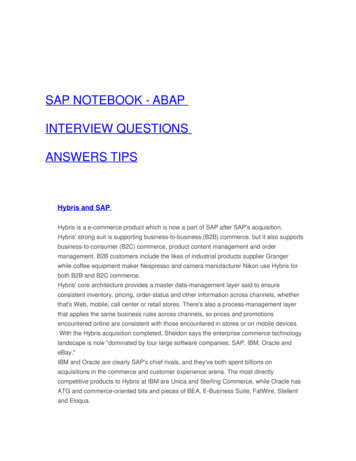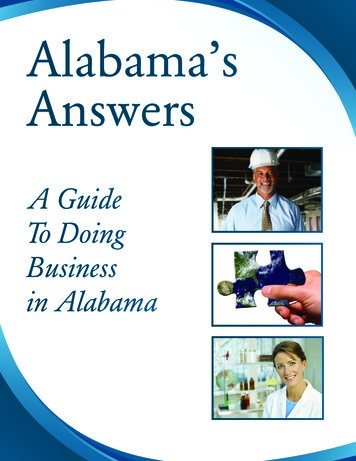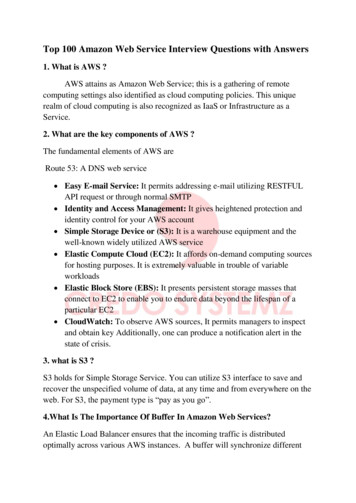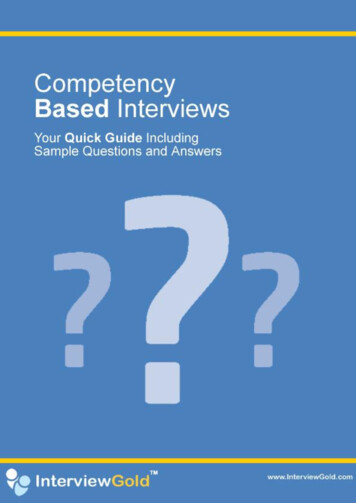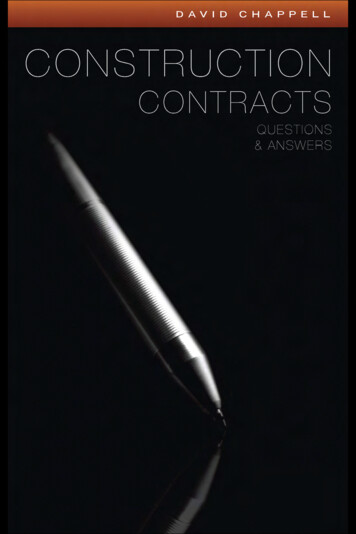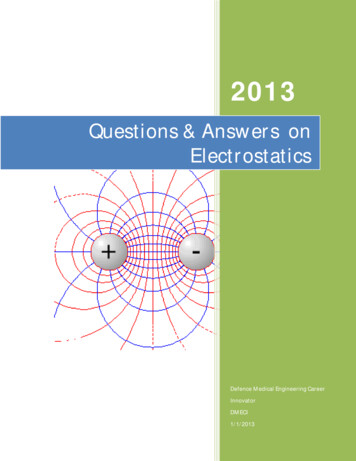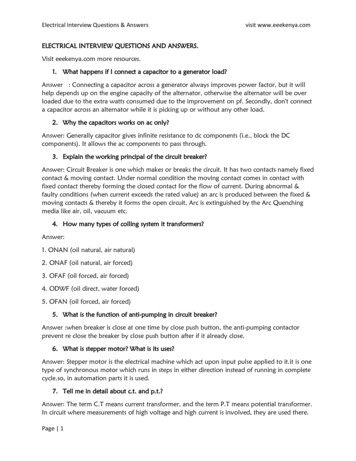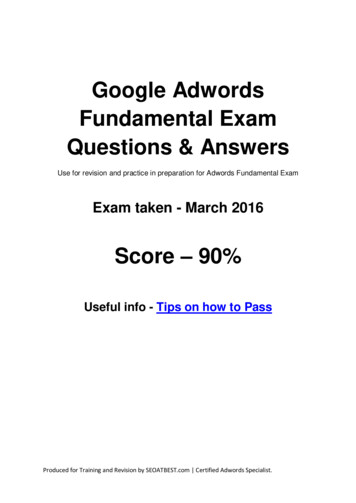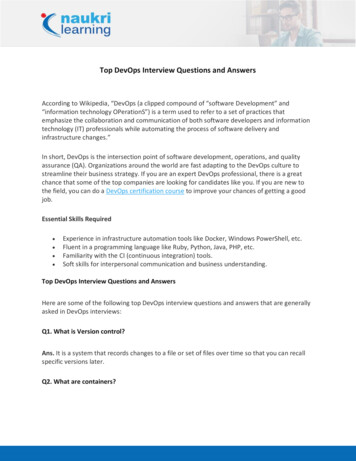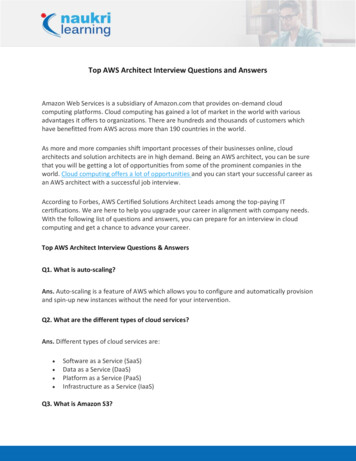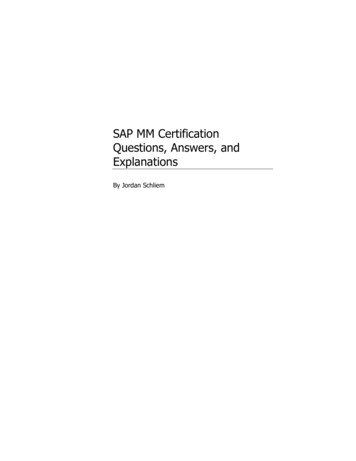
Transcription
SAP MM CertificationQuestions, Answers, andExplanationsBy Jordan Schliem
SAP MM INTERVIEW Q&APlease visit our website at www.sapcookbook.com 2005 Equity Press all rights reserved.ISBN 0975305263All rights reserved. No part of this publication may bereproduced, stored in a retrieval system, or transmittedin any form or by any means, electronic, mechanical,photocopying, recording or otherwise, without eitherthe prior written permission of the publisher or a licensepermitting restricted copying in the United States orabroad.The programs in this book have been included forinstructional value only. They have been tested withcare but are not guaranteed for any particular purpose.The publisher does not offer any warranties orrepresentations not does it accept any liabilities withrespect to the programs.Trademark noticesSAP and SAP MM are registered trademarks of SAP AG.This publisher gratefully acknowledges SAP permissionto use its trademark in this publication. SAP AG is notthe publisher of this book and is not responsible for itunder any aspect of the law.-2-
SAP MM INTERVIEW Q&ASAP MM Certification Questions, Answers,and Explanations 1Motivation 12Introduction 14The SAP Guru has Spoken! 14Part I: Conceptual Questions 15Question 1: What MRP procedures are available in MMCBP (Consumption Based Planning)? 16Question 2: Under what conditions are “planned orders”created? What may planned orders be converted toand how is that conversion accomplished? 17Question 3: What are the organizational levels of theEnterprise Structure in R/3? 18Question 4: What are the different ways to organizepurchasing organizations? 19Question 5: What are “Special Stocks”? 20Question 6: What are some of the options available totransfer materials from one plant to another? 21Question 7: What are some of the common StockTransport Order Movement Types? 22Question 8: What is the difference between a PurchaseOrder and a Purchase Requisition? 23Question 9: What is an “indirectly created” PurchaseRequisition? 24Question 10: What is an RFQ and how is it differentfrom the Quotation Form? 25Question 11: What are the transactions that will resultin a change of stock? 26Question 12: When would it be prudent to post goodsmovements via the Shipping Application? 27Question 13: What is a Reservation? 28Question 14: Can you manually generate a PurchaseRequisition referencing a Purchase Order or aScheduling Agreement? 29-3-
SAP MM INTERVIEW Q&A29Question 15: How is GR/IR account related toInventory?30Question 16: How do planned and unplannedconsumption affect Movement Types? 31Question 17: What are Departmental Views? 32Question 18: Is Material Data valid for all organizationallevels? 33Question 19: Why would you want to create physicalinventory sheets to perform an inventory cycle-count ona material or materials? 34Question 20: What is the difference between a BlanketPurchase Order and the Framework Order? 35Question 21: What is Release Procedure? 36Question 22: If you have a multi-line-item PO, can yourelease the PO item by item? 37Question 24: What is a price comparison? 39Question 25: What is a Source List? 40Question 26: What are the various “steps” in the MMCycle from material creation through invoice? 41Question 27: Give some examples of the informationrelating to a material’s storage/warehousing? 42Question 28: What are the various features ofConsignment Stocks? 43Question 29: What is a Quotation? 45Question 30: What is the Source List? 46Question 31: What is an Invoice Verification? 47Question 32: What are the different types of InvoiceVerification? 48Part II: Configuration Related Questions 51Question 34: How do you create a movement type?When will movement type numbers be odd? 52Question 35: How do you adopt standard settings forthe Message Determination Facility In MM-PUR? 53-4-
SAP MM INTERVIEW Q&AQuestion 36: How do you set price control for receipts(goods/invoice) telling the system how to value stocks?54Question 37: How do you access the MaterialsManagement Configuration Menu? 55Question 38: How are the various MM configurationTransactions accessed? 56Question 39: What are some of the more importantMaterials Management Tables? 57Question 40: Can you add custom fields to POs andRFQs? 5858Question 41: Where can you dictate how PlannedOrders are converted into Requisitions in MRP? 60Question 42: What SAP program is used to update orcreate Material Master Records? 61Question 43: What Views are possible for a material? 62Question 44: When can a Production Resource/Tool bedefined as a material? 63Question 45: When creating a new Material, what mayprompt some of the possible Material Types? 64Question 46: How do you determine which views of amaterial need to be added or to see which plants amaterial has been extended to? 65Question 47: How can you set user defaults for viewsand organizational levels? 66Question 48: What needs to be present in order forMaterial Type to be automatically copied from one viewto another? 67Question 49: How do you create a document/e-mailnotifying your supplier or internal personnel when aninvoice plan is settled? 68Question 50: How can one keep users from usingstandard MM Movement Types? 69-5-
SAP MM INTERVIEW Q&AQuestion 51: How do you define a Release Procedurefor PRs and POs? 70Question 52: How do you Change Characteristic? 71Question 53: How do you create a Class? 72Question 54: How do you configure the ReleaseProcedure? 73Question 55: Will ROH have a sales view? Will FERThave a purchasing view? 74Question 56: Where do we create Vendor AccountGroups, or screen layout in Vendor Master? 75Question 57: What are the key fields for the MaterialMaster? 76Question 58: What are the main Purchasing Tables? 77Question 59: How do you create a material? 78Question 60: What are some of the data points providedby Purchasing for a material? 79Question 61: What are the Lot Size attributes a materialcan posses? 80Question 62: How do you create a Vendor? 81Question 64: What data does the Information Recordcontain? 83Question 65: How do you create the Information Recordbased on the Material Master record? 84Question 66: What are some of the initial configurationsteps for Purchase Requisitions? 85Question 67: When, in initial configuration, why wouldyou have to Setup Stock Transport Order? 86Question 68: What are some of the initial configurationsteps for Inventory Management? 87Question 69: What are some of the initial configurationsteps for Physical Inventory? 88Part III: Practical/Troubleshooting RelatedQuestions 89Question 70: How can you process vendor returnswithout a Purchase Order reference? 90Question 71: How can an invoice be verified? 91Question 72: How do you change the standard price inthe Material Master? 92-6-
SAP MM INTERVIEW Q&AQuestion 73: How do you perform a Goods Receipt? 93Question 74: How can you post a Goods Receipt if thePO number is not known? 94Question 75: How do you display a list of allreservations in the system? 95Question 76: If you have created a custom MovementType and you get a “not allowed” error, where shouldyou first look for the cause? 96Question 77: How do you find the logical value for stockitem by date? 97Question 78: How can you disable a Reservation inMRP? 98Question 79: How do you add an attachment to aPurchase Order? 99Question 80: How do you generate an automatic POafter creating a PR using a particular material? 100Question 81: Where is the Header level and Item leveldata saved in a PO? 101Question 82: Where is Material Master data saved? 102Question 83: How do we know if a PO has been issued?103Question 84: What is the difference between a PR witha Master Record and without a Master Record for thematerial being ordered? 104Question 85: Can you change a Purchase Requisitionafter it has been created? 105Question 86: How do we create Consignment Stocks?106Question 87: What is Vendor Evaluation and how doyou maintain it? 107Question 88: What are the components of the MasterData that details a company’s procurement; used by,Vendor Evaluation for example? 108Question 89: How do we get a proper list of vendors tosend an RFQ? 109Question 90: How do you create a Source List? 110Question 91: How will items be returned to the vendor?111Question 92: Where do you perform a Goods Issue? 112-7-
SAP MM INTERVIEW Q&AQuestion 93: How do you perform a Goods Issue? 113Question 94: How do you perform an InvoiceVerification? 114Question 95: How do you display parked documents?115Question 96: What do the W, V, and F fields showabout the status of a document in FBV3? 116Question 97: If you are using Transaction MRKO,vendor settlement, and we get an error message(FS217 or M8443 etc.), how would you go abouttroubleshooting this? 118INDEX 121-8-
SAP MM INTERVIEW Q&AHello,Thank you for buying this book. I’ve spent sometime designing it so that you might find it apurposeful and efficient way to meet yourobjectives. The MM Q&A Book was intended forthose who want to be able to ask meaningfulquestions of their prospective hires of course, but itis also a fine tool for the consultant to practice hisinterviewing skills, or simply learn more about SAPMM.MM Q&A is split up into three distinct flavors ofquestions. The first section of the book containsquestions that will allow you to ascertain yourprospective employee’s/contractor’s grasp of the“Big Picture”. These questions were purposefullycreated with the intent of drawing out a person’soverall understanding of the procurement cycle.The next section of the book is filled with questionsdealing with configuration. Proper answers hereshould give you the assurance that the personyou’re interviewing knows where to go to properlycustomize your system to your needs. Lastly, thethird section of this book will gives you questionsthat will prove actual hand-on experience using thesystem. The day to day activities andtroubleshooting skills necessary to properly train,debug, and test for your MM implementation.-9-
SAP MM INTERVIEW Q&ANow, although the answers presented here are tested,tried, and true, it may be more enlightening for you tolook more for the logical steps involved in an answer.Some of the conceptual questions aside (a PurchaseOrder is a Purchase Order), there are sometimes manydiffering ways to achieve the same objective in SAP’sMM, but the logic of attacking most problems will befairly universal. Also, I’ve found that a person whodoesn’t know the answer to a problem, but has a goodplan of attack (for getting the information), possesses astrong trait. For the ultimate example of this line ofthought, check out the last question in this book. Itprobably is too specific and nobody will believe thatyou’re asking them this with a straight face. Go aheadand throw it at them though the way the question ishandled will lend much more light on a person’scompetence than what is specifically said. I wish youthe best of luck and I hope this book serves you well.Jordan SchliemLaguna Niguel, California- 10 -
SAP MM INTERVIEW Q&A- 11 -
SAP MM INTERVIEW Q&AMotivationDuring the course of an average project, I am usuallycalled upon by a project manager to “help screenresources” for different parts of the project. And onething comes to mind – if done properly, it’s very timeconsuming, and it’s really hard work!My interviews usually sound something like this –Jim: “Please rate yourself, on a scale of 1-10 on yourSRM knowledge and experience ”Interviewee: “Um, probably something like 10 ”Jim: “OK, so, let me just say something. I don’tbelieve there is such a thing as a ten.”Interviewee: “What would you rate yourself?”Jim: “I rate myself an 8.”Interviewee: “Why so low?”Jim: “There’s no such thing as a ten. All of the nines areworking at SAP, SAP Labs, or SAP Consulting, and sobasically that puts me at about an eight. But we’re hereto talk about your skills. And so you think you’re a 10,huh? OK, so tell me what you know about debuggingthe n-step approval workflow ”And then I try to ask the questions that truly flesh out aperson’s understanding of the software. It’s part- 12 -
SAP MM INTERVIEW Q&Ascience, part art to be sure – but the #1 thing I’mlooking for in an interview is that the resourcerepresents their skills truthfully. The good resourcesknow what they know, know what they don’t know, andthey’re open about it.And so I hope that this book will serve as a muchneeded guide for managers trying to get the rightresource for their project. If you construct an interviewbased on these questions, I’m confident you can get agood idea about the depth and breadth of aconsultant’s experiences and accumulated knowledge.Jim StewartPresident EquityPressDetroit, MichiganAugust 2005- 13 -
SAP MM INTERVIEW Q&AIntroductionThis book is divided into three parts – conceptualquestions related to MM, questions dealing with MMconfiguration, and finally, questions designed to let ushave an understanding of an applicant’s practicalknowledge and troubleshooting skills.Each interview question has a question and an answer– that is pretty straightforward – but when you see theguru icon – this is information that represents thehighest degree of knowledge in a particular area. So ifyou’re looking for a “guru” be sure to listen for ananswers similar to those given under the guru icon.Don’t be bamboozled!The SAP Guru has Spoken!- 14 -
SAP MM INTERVIEW Q&APart I: ConceptualQuestions- 15 -
SAP MM INTERVIEW Q&AQuestion 1: What MRP procedures areavailable in MM-CBP (Consumption BasedPlanning)?A: Various material planning methods are used inMRP (Material Requirements Planning).Reorder point procedure (VM)Forecast-based planning (VV)Time-Phased materials planning (PD)These are specified in material creation (MM01)under the MRP 1 tab.- 16 -
SAP MM INTERVIEW Q&AQuestion 2: Under what conditions are“planned orders” created? What mayplanned orders be converted to and how isthat conversion accomplished?A: Planned orders are always created when thesystem creates an internal
SAP MM Certification Questions, Answers, and Explanations 1 Motivation 12 Introduction 14 The SAP Guru has Spoken! 14 Part I: Conceptual Questions 15 Question 1: What MRP procedures are available in MM-CBP (Consumption Based Planning)? 16 Question 2: Under what conditions are “planned orders” created? What may planned orders be converted to and how is that conversion

